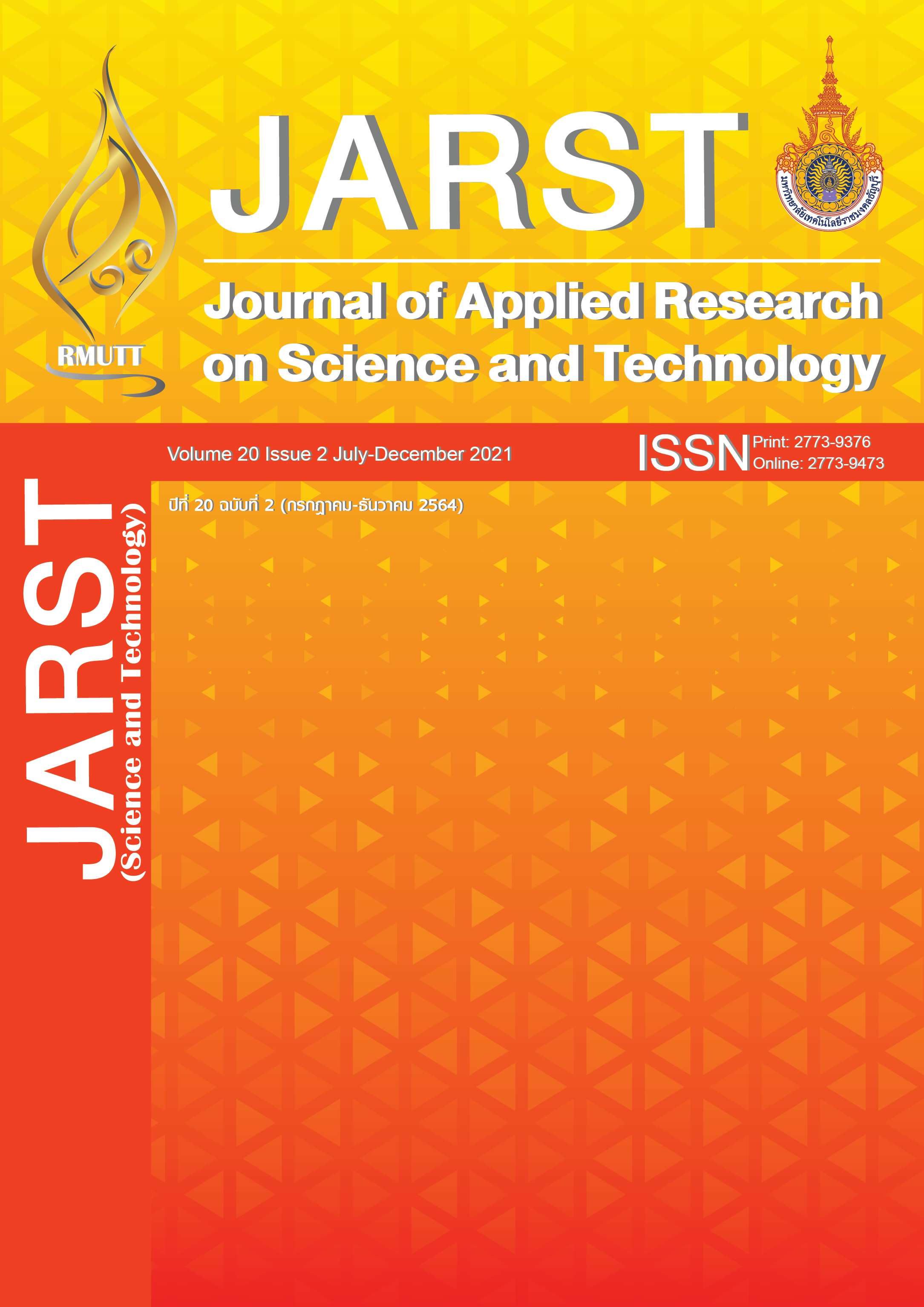The Study of Thin Layer Drying Model of Chili
Main Article Content
Abstract
The objective of this research was to study a thin layer drying model as an efficient mathematical model in order to determine the optimize model to study the relationship between the ratio of moisture and the time for chili. The researcher brought chili, which has a mass and initial moisture value, in the range of 42-52 g and 330-380%, d.b., respectively. Then, it drying with temperature control equal to 50ºC, 60ºC and 70ºC, and the relative humidity values of air were 10%, 20% and 30% at wind speed equal to 1 m/s. There will be a total of 9 trials. The dryer used in this experiment consisted of two main parts: 1) the relative humidity control of the air inside the machine, which is a glass chamber and ceramic packed system for producing saturated air, and 2) the control section temperature which is a temperature control button on the outside and temperature can be adjusted as needed. The experimental results found that the last moisture content ranges from 6-8%, d.b. Then, the results of the experiments were then used to calculate the moisture content and moisture ratio from the chili experiments for calculation and compared to the moisture ratio obtained from a total of 6 models. According to the results of the model's accuracy test, the models suitable for chili for all temperatures and humidity were the Wang and Singh models, which yielded differences in the form of RMSD and MBD in the range of 2.78 – 6.86% and -0.20 – 2.95%, respectively.
Article Details

This work is licensed under a Creative Commons Attribution-NonCommercial-NoDerivatives 4.0 International License.
References
Warinthorn P, Purin A, Kannapot K. Study on drying method of rose tea. RJ-RMUTT. 2017;16(1-2):1-9.
Ismailova AA. Possibilities of applying solar energy to dry fruits and vegetable. Teptoenergetika. 1957;1:1-22.
Lof GOG. Solar energy for drying of solids. Sol Energy. 1962;6(4):122-8.
Khan EU. Practical devices for the utilization of solar energy. Sol Energy. 1964;8(1):17-22.
Lawand TA. A solar–cabinet dryer. Sol Energy. 1966;10(4):158-63.
Murthy MVR. A review of new technologies, models and experimental investigations of solar driers. Renew Sust Energ Rev. 2009;13(4):835-44.
Fudholi A, Sopian K, Ruslan H, Alghoul MA, Sulaiman MY. Review of solar dryers for agricultural and marine products. Renew Sust Energ Rev. 2010;14:1-30.
Janjai S, Bala BK. Solar drying technology. Food Eng Rev. 2012;4:16-54.
Henderson S. Progress in developing the thin layer drying equation. T ASAE. 1974;17(6):1167-8.
Wang CY, Singh RP. Use of variable equilibrium moisture content in modelling rice drying. Transactions of American Society of Agricultural Engineers. 1978;11(6):668-72.
Zhang Q, Litchfield J. An optimization of intermittent corn drying in a laboratory scale thin layer dryer. Dry Technol. 1991;9(2):383-95.
Karathanos VT, Belessiotis VG. Application of a thin-layer equation to drying data of fresh and semi-dried fruits. J Agr Eng Res. 1999;74(4):355-61.
Togrul IT, Pehlivan D. Mathematical modelling of solar drying of apricots in thin layers. J Food Eng. 2002;55(3):209-16.
Das I, Das SK, Bal S. Drying kinetics of high moisture paddy undergoing vibration-assisted infrared (IR) drying. J Food Eng. 2009;95(1):166-71.
Bala BK. Solar drying systems: simulations and optimization. 1st Edition. Udaipur: Agrotech Publishing Academy; 1998.
Khawas P, Das AJ, Dash KK, Deka SC. Thin-layer drying characteristics of Kachkal banana peel (Musa ABB) of Assam, India. Int Food Res J. 2014;21(3):975-82.
Panchariya PC, Popovic D, Sharma AL. Thin layer modelling of black tea drying process. J Food Eng. 2002;52(4):349-57.
Hii CL, Law CL, Cloke M. Modelling using a new thin layer drying model and product quality of cocoa. J Food Eng. 2009;90(2):191-8.


